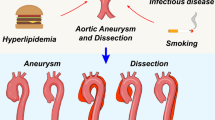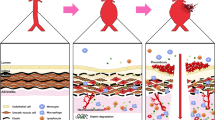Abstract
Abdominal aortic aneurysms (AAAs) have devastating effects on the morbidity and mortality of a large portion of the elderly population. Current therapeutic options for AAAs are limited to surgical approaches, because there are no proven pharmacologic treatments. Recently, there is evolving evidence that angiotensin II (Ang II) participates in the initiation and propagation of AAAs. Animal studies have consistently demonstrated the ability of Ang II to promote the formation of AAAs, although the mechanisms of this effect have not been defined. Further definition of the role of the renin-angiotensin system in AAA formation and progression will identify potential therapeutic strategies for treatment of this disease.
Similar content being viewed by others
References and Recommended Reading
Rutherford RB, Krupski WC: Current status of open versus endovascular stent-graft repair of abdominal aortic aneurysm. J Vasc Surg 2004, 39:1129–1139.
owell JT, Greenhalgh RM: Small abdominal aortic aneurysms. N Engl J Med 2003, 348:1895–1901.
Thompson MM, Bell PR: ABC of arterial and venous disease: arterial aneurysms. BMJ 2000, 320:1193–1196.
Danser AH: Local renin-angiotensin systems: the unanswered questions. Int J Biochem Cell Biol 2003, 35:759–768.
Huang W, Alhenc Gelas F, Osborne-Pellegrin MJ: Protection of the arterial internal elastic lamina by inhibition of the reninangiotensin system in the rat. Circ Res 1998, 82:879–890.
Nishijo N, Sugiyama F, Kimoto K, et al.: Salt-sensitive aortic aneurysm and rupture in hypertensive transgenic mice that overproduce angiotensin II. Lab Invest 1998, 78:1059–1066.
Daugherty A, Cassis L: Chronic angiotensin II infusion promotes atherogenesis in low density lipoprotein receptor-/-mice. Ann NY Acad Sci 1999, 892:108–118.
Daugherty A, Manning MW, Cassis LA: Angiotensin II promotes atherosclerotic lesions and aneurysms in apolipoprotein Edeficient mice. J Clin Invest 2000, 105:1605–1612. first paper that published the unanticipated finding that infusion of Ang II promotes the formation of AAA in hyperlipidemic mice.
Deng GG, Martin-McNulty B, Sukovich DA, et al.: Urokinasetype plasminogen activator plays a critical role in angiotensin II-induced abdominal aortic aneurysm. Circ Res 2003, 92:510–517.
Cassis LA, Helton MJ, Howatt D, et al.: Aldosterone does not mediate angiotensin II-induced atherosclerosis and abdominal aortic aneurysms. 2004, In press.
Saraff K, Babamusta F, Cassis LA, Daugherty A: Aortic dissection precedes formation of aneurysms and atherosclerosis in angiotensin II-infused, apolipoprotein E-deficient mice. Arterioscler Thromb Vasc Biol 2003, 23:1621–1626.
Owell JT, Brady AR: Detection, management, and prospects for the medical treatment of small abdominal aortic aneurysms. Arterioscler Thromb Vasc Biol 2004, 24:241–245.
Daugherty A, Cassis LA: Mouse models of abdominal aortic aneurysms. Arterioscler Thromb Vasc Biol 2004, 24:429–434.
Manning MW, Cassis LA, Huang J, et al.: Abdominal aortic aneurysms: fresh insights from a novel animal model of the disease. Vasc Med 2002, 7:45–54.
Henriques TA, Huang J, D’Souza SS, et al.: Orchiectomy, but not ovariectomy, regulates angiotensin II-induced vascular diseases in apolipoprotein E-deficient mice. Endocrinology 2004, 145:3866–3872.
Martin McNulty B, Tham DM, daCunha V, et al.: 17 betaestradiol attenuates development of angiotensin II induced aortic abdominal aneurysm in apolipoprotein E deficient mice. Arterioscler Thromb Vasc Biol 2003, 23:1627–1632.
Daugherty A, Manning MW, Cassis LA: Antagonism of AT2 receptors augments angiotensin II-induced abdominal aortic aneurysms and atherosclerosis. Br J Pharmacol 2001, 134:865–870.
Zhou Y, Chen Y, Dirksen WP, et al.: AT1b receptor predominantly mediates contractions in major mouse blood vessels. Circ Res 2003, 93:1089–1094.
Daugherty A, Rateri DL, Lu H, et al.: Deficiency of AT1a receptors decreases hypercholesterolemic induced atherosclerosis: association with stimulation of both local and systemic renin-angiotensin systems. 2004, In press.
Siragy HM, Carey RM: Angiotensin type 2 receptors: potential importance in the regulation of blood pressure. Curr Opin Nephrol Hypertens 2001, 10:99–103.
Strawn WB, Chappell MC, Dean RH, et al.: Inhibition of early atherogenesis by losartan in monkeys with diet-induced hypercholesterolemia. Circulation 2000, 101:1586–1593. first large animal demonstration that the administration of the AT1 receptor antagonist, losartan, decreases the size of lesions. This decrease was associated with beneficial changes in inflammatory markers and propensity to oxidize LDL.
Daugherty A, Rateri DL, Inagami T, Cassis LA: PD123319 augments atherosclerosis and abdominal aortic aneurysm formation through AT2 receptor-independent mechanisms. 2004, In press.
Wang YX, Martin McNulty B, Freay AD, et al.: Angiotensin II increases urokinase-type plasminogen activator expression and induces aneurysm in the abdominal aorta of apolipoprotein E-deficient mice. Am J Pathol 2001, 159:1455–1464.
Manning MW, Cassis LA, Daugherty A: Differential effects of doxycycline, a broad-spectrum matrix metalloproteinase inhibitor, on angiotensin II-induced atherosclerosis and abdominal aortic aneurysms. Arterioscler Thromb Vasc Biol 2003, 23:483–488.
Bruemmer D, Collins AR, Noh G, et al.: Angiotensin II-accelerated atherosclerosis and aneurysm formation is attenuated in osteopontin-deficient mice. J Clin Invest 2003, 112:1318–1331.
Anidjar S, Salzmann JL, Gentric D, et al.: Elastase-induced experimental aneurysms in rats. Circulation 1990, 82:973–981. lassic paper in experimental abdominal aortic aneurysm research that demonstrates the disease promoted by infrarenal infusion of elastase.
Pyo R, Lee JK, Shipley JM, et al.: Targeted gene disruption of matrix metalloproteinase-9 (gelatinase B) suppresses development of experimental abdominal aortic aneurysms. J Clin Invest 2000, 105:1641–1649. escription of a mouse model in which AAAs were generated by infusion of elastase into the infrarenal aorta. This was the first description of the use of mice with deficiencies in matrix metalloproteinase to determine their role in aneurysm formation.
Liao S, Miralles M, Kelley BJ, et al.: Suppression of experimental abdominal aortic aneurysms in the rat by treatment with angiotensin-converting enzyme inhibitors. J Vasc Surg 2001, 33:1057–1064.
Daugherty A, Ravisankar P, Szilvassy SJ, et al.: Deficiency of CCR2 reduces angiotensin II-induced atherosclerosis and aneurysm formation in apolipoprotein E-/-mice. Arterioscler Thromb Vasc Biol 2004, In press.
Miralles M, Wester W, Sicard GA, et al.: Indomethacin inhibits expansion of experimental aortic aneurysms via inhibition of the cox2 isoform of cyclooxygenase. J Vasc Surg 1999, 29:884–893.
Walton LJ, Franklin IJ, Bayston T, et al.: Inhibition of prostaglandin E2 synthesis in abdominal aortic aneurysms: implications for smooth muscle cell viability, inflammatory processes, and the expansion of abdominal aortic aneurysms. Circulation 1999, 100:48–54.
Hu ZW, Kerb R, Shi XY, et al.: Angiotensin II increases expression of cyclooxygenase-2: implications for the function of vascular smooth muscle cells. J Pharmacol Exp Ther 2002, 303:563–573.
Arenas IA, Xu Y, Lopez-Jaramillo P, Davidge ST: Angiotensin IIinduced MMP-2 release from endothelial cells is mediated by TNF-alpha. Am J Physiol 2004, 286:C779-C784.
Vaughan DE, Lazos SA, Tong K: Angiotensin II regulates the expression of plasminogen activator inhibitor-1 in cultured endothelial cells: a potential link between the renin-angiotensin system and thrombosis. J Clin Invest 1995, 95:995–1001.
Nishimoto M, Takai S, Fukumoto H, et al.: Increased local angiotensin II formation in aneurysmal aorta. Life Sci 2002, 71:2195–2205.
Hamano K, Ohishi M, Ueda M, et al.: Deletion polymorphism in the gene for angiotensin-converting enzyme is not a risk factor predisposing to abdominal aortic aneurysm. Eur J Vasc Endovasc Surg 1999, 18:158–161.
Yeung JM, Heeley M, Gray S, et al.: Does the angiotensinconverting enzyme (ACE) gene polymorphism affect rate of abdominal aortic aneurysm expansion? Eur J Vasc Endovasc Surg 2002, 24:69–71.
Pola R, Gaetani E, Santoliquido A, et al.: Abdominal aortic aneurysm in normotensive patients: association with angiotensin-converting enzyme gene polymorphism. Eur J Vasc Endovasc Surg 2001, 21:445–449.
Wilmink AB, Vardulaki KA, Hubbard CS, et al.: Are antihypertensive drugs associated with abdominal aortic aneurysms? J Vasc Surg 2002, 36:751–757.
Ejiri J, Inoue N, Tsukube T, et al.: Oxidative stress in the pathogenesis of thoracic aortic aneurysm: protective role of statin and angiotensin II type 1 receptor blocker. Cardiovasc Res 2003, 59:988–996.
Thompson RW, Baxter BT: MMP inhibition in abdominal aortic aneurysms: rationale for a prospective randomized clinical trial. Ann NY Acad Sci 1999, 878:159–178.
Stanton A: Potential of renin inhibition in cardiovascular disease. J Renin Angiotensin Aldosterone Syst 2003, 4:6–10.
Author information
Authors and Affiliations
Rights and permissions
About this article
Cite this article
Daugherty, A., Cassis, L. Angiotensin II and abdominal aortic aneurysms. Current Science Inc 6, 442–446 (2004). https://doi.org/10.1007/s11906-004-0038-0
Issue Date:
DOI: https://doi.org/10.1007/s11906-004-0038-0




